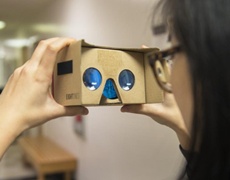Virtual reality makes journalism immersive, realism makes it credible
11 Dec 2017
Virtual reality technology may help journalists pull an audience into their stories, but they should avoid being too flashy, or their credibility could suffer, according to a team of researchers.
 In a study, participants indicated that stories experienced in virtual reality -- VR -- significantly outperformed text-based articles in several categories, such as giving them a sense of presence, or the feeling of being there, and increasing their empathy for the story's characters, said S. Shyam Sundar, distinguished professor of communications and co-director of the Media Effects Research Laboratory.
In a study, participants indicated that stories experienced in virtual reality -- VR -- significantly outperformed text-based articles in several categories, such as giving them a sense of presence, or the feeling of being there, and increasing their empathy for the story's characters, said S. Shyam Sundar, distinguished professor of communications and co-director of the Media Effects Research Laboratory.
Using a cardboard VR viewer for experiencing 360-degree videos was better than interacting with the same videos on a computer screen, he added.
"VR stories provide a better sense of being right in the midst of the story than text with pictures and even 360-degree video on a computer screen," says Sundar. "This is remarkable given that we used two stories from the New York Times Magazine, which were high quality and rich in imagery even in the text version."
Although virtual reality outperformed text and video, the researchers cautioned that relying on some of the flashier design elements of virtual reality may affect credibility and cause the audience to have less trust in the story. They discovered that evoking a higher sense of "being there" was associated with lower trustworthiness ratings of the New York Times.
"What really makes people trust VR more is that it creates a greater sense of realism compared to text and that creates the trustworthiness," says Sundar. "But, if it doesn't give that sense of realism, it can affect credibility. If developers try to gamify it or make it more fantasy-like, for example, people may begin to wonder about the credibility of what they're seeing."
That said, the immersive quality of virtual reality and 360-degree video may make the content more shareable, according to the researchers, who report their findings in the current issue of Cyberpsychology, Behavior and Social Networking.
"Virtual reality is often called an empathy machine," says Sundar. "And, consistent with that thought, we did find that participants in both the VR and 360-degree video conditions were more empathetic toward the story characters than their counterparts in the text condition and they also reported higher intention to share the story with others."
Journalists on a tighter budget may consider using 360-degree videos. These videos, which allow users to rotate their view, are more immersive than the text-based story. However, these videos were unable to match virtual reality's ability to make the audience feel like they are in the story, said Sundar.
"On many things 360-degree video on a computer does as well as viewing it on a VR viewer, so you might not need to go through the trouble of putting together the cardboard viewer and slipping in the phone to experience it," he adds. "But, for being transported to the scene of the action, the VR viewer beats it."
The researchers noted that VR and 360-degree video demand more attention, which can hurt readers' recall of story details.
"We found some evidence to suggest that memory was affected by all the interaction with immersive journalism, but more research is needed to fully understand this effect," said Sundar.
The researchers recruited 129 participants and asked them to either read two stories in a magazine, watch the stories using 360-degree video, or use a cardboard virtual-reality reader provided by the newspaper company to view the stories.
They asked volunteers to read two stories with different emotional intensity. The more emotional story -- The Displaced -- focused on the lives of three refugees.
The other story -- The Click Effect -- examined marine biologists' efforts to understand the vocalisations of dolphins. In general, the effects of immersive journalism were more pronounced with the less emotional story.
The virtual reality stories were accessed through the newspaper's mobile app.




















